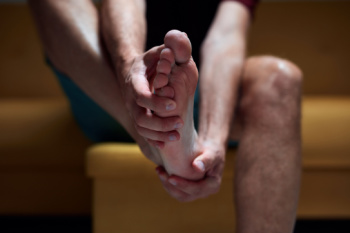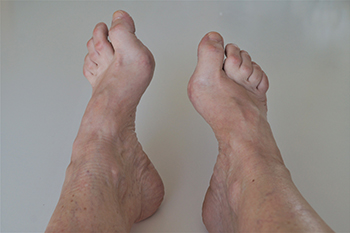
Plantar fasciitis causes pain in the heel, arch, and bottom of the foot, often making it difficult for people to walk comfortably, especially after periods of rest. Stretching the feet, toes, and ankles can help reduce discomfort by easing pressure on the plantar fascia, a band of tissue under the foot that supports the arch. Simple stretches, such as gently pulling the toes back while seated or rolling the foot over a round object, can improve flexibility and reduce strain on the plantar fascia. These plantar fasciitis exercises are most effective when done regularly and may support healing by loosening tight muscles and promoting better foot function. Continuing the stretches even after pain recedes may help lower the risk of recurrence. Warming up before physical activity and stretching the calf muscles afterward can also improve foot mechanics. Supportive footwear plays an important role in protecting the arch during daily movement. A podiatrist can diagnose plantar fasciitis and recommend exercises as well as footwear that support recovery. If you have foot pain associated with plantar fasciitis, it is suggested that you schedule an appointment with a podiatrist for an exam and appropriate treatment.
Plantar fasciitis can be very painful and inconvenient. If you are experiencing heel pain or symptoms of plantar fasciitis, contact David K. Morris, DPM from Florida. Our doctor can provide the care you need to keep you pain-free and on your feet.
What Is Plantar Fasciitis?
Plantar fasciitis is the inflammation of the thick band of tissue that runs along the bottom of your foot, known as the plantar fascia, and causes mild to severe heel pain.
What Causes Plantar Fasciitis?
- Excessive running
- Non-supportive shoes
- Overpronation
- Repeated stretching and tearing of the plantar fascia
How Can It Be Treated?
- Conservative measures – anti-inflammatories, ice packs, stretching exercises, physical therapy, orthotic devices
- Shockwave therapy – sound waves are sent to the affected area to facilitate healing and are usually used for chronic cases of plantar fasciitis
- Surgery – usually only used as a last resort when all else fails. The plantar fascia can be surgically detached from the heel
While very treatable, plantar fasciitis is definitely not something that should be ignored. Especially in severe cases, speaking to your doctor right away is highly recommended to avoid complications and severe heel pain. Your podiatrist can work with you to provide the appropriate treatment options tailored to your condition.
If you have any questions please feel free to contact our office located in Plantation, FL . We offer the newest diagnostic and treatment technologies for all your foot and ankle needs.

Stretching the feet and ankles is essential for maintaining flexibility, strength, and injury prevention in runners. Regular stretching improves mobility, reduces strain on muscles, and enhances overall performance. A simple exercise that strengthens foot muscles involves picking up small objects, such as marbles or coins, with the toes, improving grip and control. The balancing act helps with stability by standing on one foot for several seconds, gradually increasing time to enhance ankle strength and coordination. Plantar stretching targets the arch by placing one foot against a wall with toes pointing upward while gently leaning forward to stretch the sole. If you have endured a foot or ankle injury while running, it is suggested that you contact a podiatrist who can treat various foot and ankle conditions, and recommend additional running injury prevention stretches.
Exercising your feet regularly with the proper foot wear is a great way to prevent injuries. If you have any concerns about your feet, contact David K. Morris, DPM of Florida. Our doctor will treat your foot and ankle needs.
How to Prevent Running Injuries
Many common running injuries are caused by overuse and overtraining. When the back of the kneecap starts wearing out and starts causing pain in your knee, this is commonly referred to as runner’s knee. Runner’s knee is a decrease in strength in your quadriceps and can occur if you’re not wearing properly fitted or supporting shoes. To prevent runner’s knee, focusing on hip strengthening is a good idea, as well as strengthening your quads to keep the kneecaps aligned.
What Are Some Causes of Running Injuries?
- One cause of a common running injury is called iliotibial band syndrome.
- Plantar fasciitis is also another common injury.
- Stress fractures can occur from overtraining, lack of calcium, or even your running style.
Best Ways to Prevent Running Injuries
- Wear footwear that fits properly and suits your running needs.
- Running shoes are the only protective gear that runners have to safeguard them from injury.
- Make a training schedule. Adding strengthening exercises as well as regular stretching can help keep you strong and limber and can lessen the possibility of injuries.
- Stretching keeps muscles limber; this will help you gain better flexibility.
If you have any questions please feel free to contact our office located in Plantation, FL . We offer the newest diagnostic and treatment technologies for all your foot and ankle needs.

High arches, or cavus foot, can cause significant pain due to the excessive pressure placed on the heel and the ball of the foot. People with high arches may experience pain when walking or standing, calluses from uneven weight distribution, curled toes, and ankle instability. Without proper support, high arches can contribute to an unsteady gait, increasing the risk of ankle sprains. A podiatrist may recommend custom orthotics to improve foot alignment and provide cushioning, foot pads to relieve pressure, or ankle braces to enhance stability. If non-surgical methods do not alleviate symptoms, surgery may be considered. For instance, a tendon transfer can help balance muscle function, while an osteotomy may be used to realign bones. In more severe cases, the plantar fascia can be partially cut to reduce arch tension and relieve pain caused by excessive tightness. Another option is fusing two or more bones in the foot to create a more stable structure. If you have high arches that cause discomfort, it is suggested that you schedule an appointment with a podiatrist for an exam, diagnosis, and treatment options, which may include surgery.
If you have any concerns about your feet, contact David K. Morris, DPM from Florida. Our doctor can provide the care you need to keep you pain-free and on your feet.
Biomechanics in Podiatry
Podiatric biomechanics is a particular sector of specialty podiatry with licensed practitioners who are trained to diagnose and treat conditions affecting the foot, ankle and lower leg. Biomechanics deals with the forces that act against the body, causing an interference with the biological structures. It focuses on the movement of the ankle, the foot and the forces that interact with them.
A History of Biomechanics
- Biomechanics dates back to the BC era in Egypt where evidence of professional foot care has been recorded.
- In 1974, biomechanics gained a higher profile from the studies of Merton Root, who claimed that by changing or controlling the forces between the ankle and the foot, corrections or conditions could be implemented to gain strength and coordination in the area.
Modern technological improvements are based on past theories and therapeutic processes that provide a better understanding of podiatric concepts for biomechanics. Computers can provide accurate information about the forces and patterns of the feet and lower legs.
Understanding biomechanics of the feet can help improve and eliminate pain, stopping further stress to the foot.
If you have any questions please feel free to contact our office located in Plantation, FL . We offer the newest diagnostic and treatment technologies for all your foot and ankle needs.




